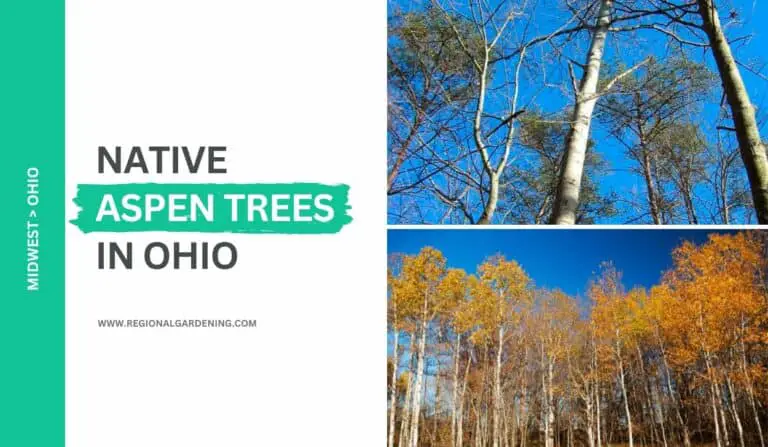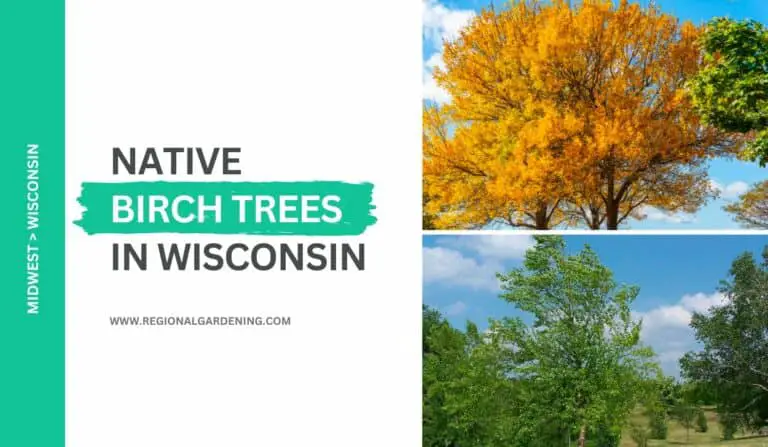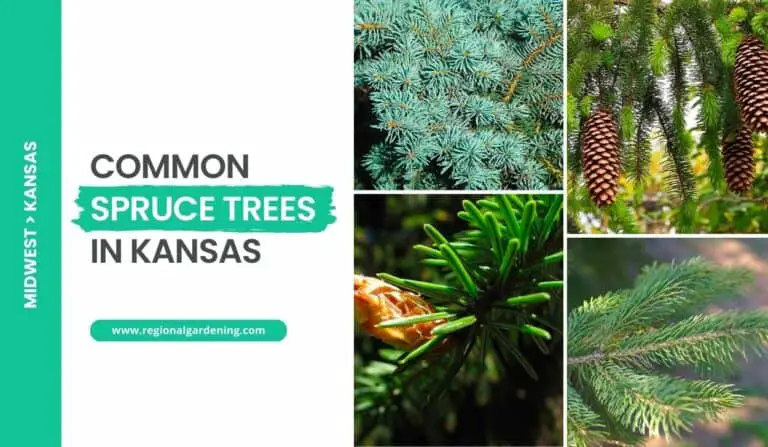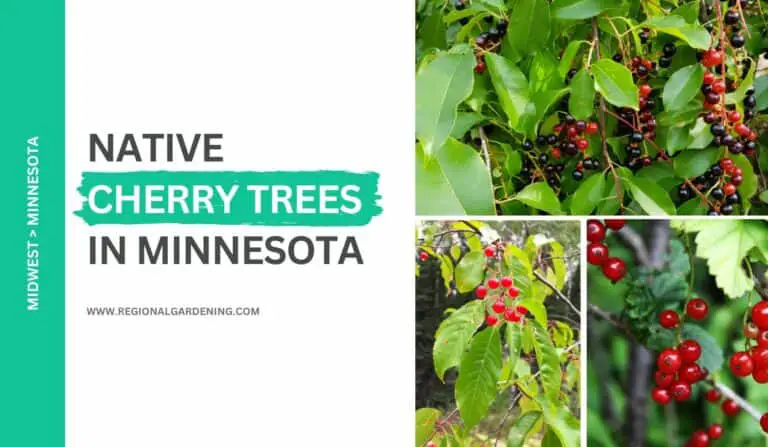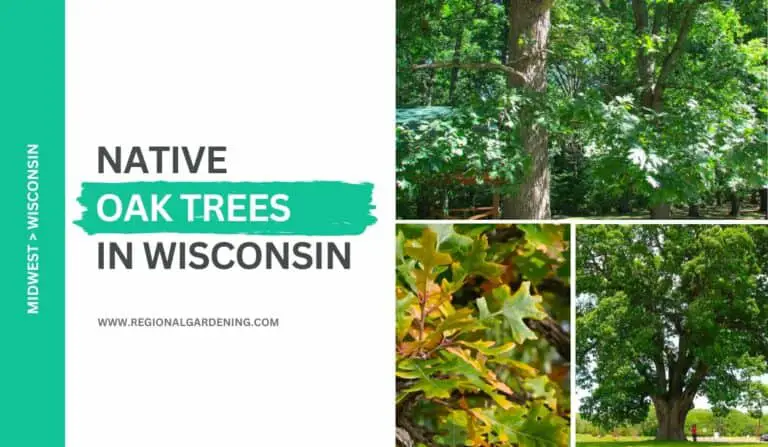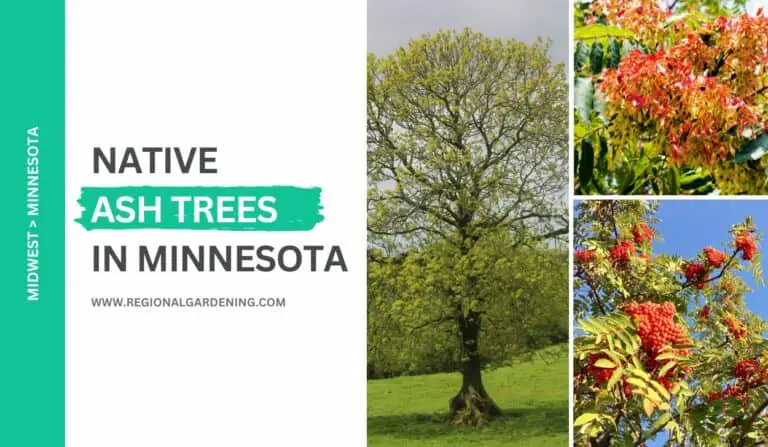6 Types Of Hickory Trees In Michigan (Photos & Identification)
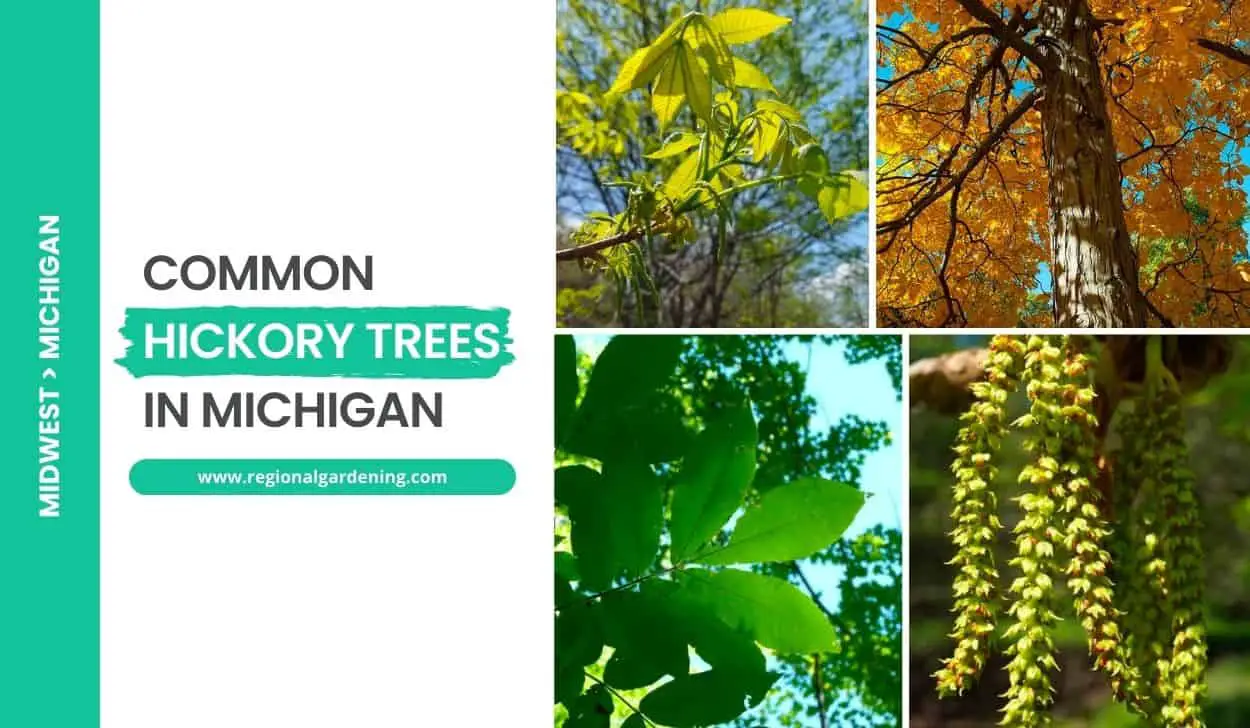
Many species of hickory trees thrive in Michigan’s varied ecosystems and rich natural resources.
These common nut-bearing trees add to the state’s visual appeal and yield a tasty and healthy crop. From the native shagbark hickory to the non-native pecan tree, Michigan offers a diverse range of hickory species to explore.
In this article, we will take a closer look into the common hickory trees in Michigan, exploring their physical characteristics, preferred habitats, and the benefits they provide to both humans and wildlife.
Let’s begin.
1. Shagbark Hickory
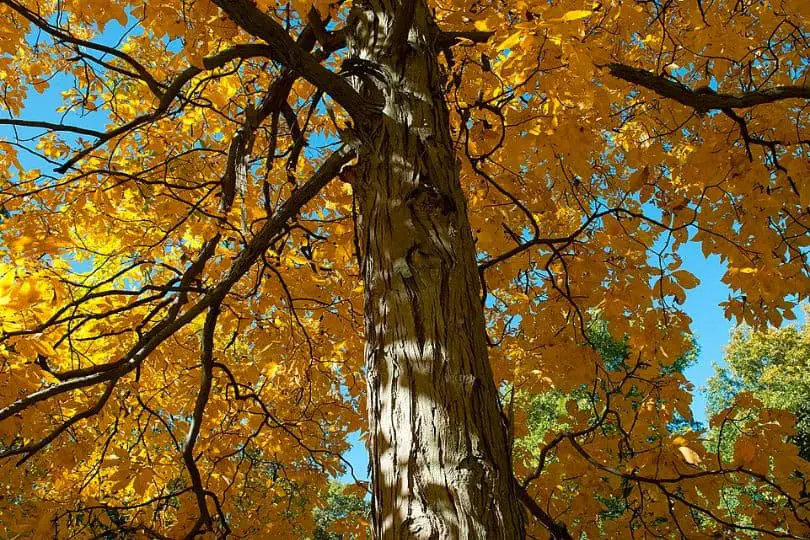
- Scientific Name: Carya ovata
- Common Name(s): Shagbark Hickory
- Mature Height: 60-80 feet (18-24 meters)
- Native Region: Native to Michigan
- Flowers: No flowers.
- Fruit: The fruit of the shagbark hickory is a nut with a hard outer husk that splits open when ripe.
- Uses: Shagbark hickory is excellent for burning and is used to make flavorful food such as hickory-smoked bacon. It is also used for making tool handles, ladder rungs, athletic equipment, furniture, and flooring. The nuts are enjoyed by black bears, foxes, mice, chipmunks, squirrels, rabbits, and several bird species. The loose, long strips of bark serve as nesting sites for the Indiana bat.
Shagbark hickory (Carya ovata) gets its name from its unusual shaggy bark. This deciduous tree has an oval shape and can grow to a height of 60-80 feet. The compound leaves, which have 5-7 leaflets, grow alternately on the branches. Shagbark hickories are indigenous to Michigan, specifically the southern Lower Peninsula.
These trees thrive in wet soils and humid climates, making them ideal for the Michigan landscape. They can be found scattered among oak, pine, and maple woodlands. The tree’s defining feature is its shaggy bark, which peels away in vast strips and lends it its name.
Shagbark hickory trees produce nuts that are encased in a tough outer shell. Several wildlife species, including black bears, foxes, mice, chipmunks, squirrels, rabbits, and several bird species, enjoy the nuts. The Indiana bat, which uses the loose bark strips as nesting sites, is one famous tenant that benefits from the bark of the shagbark hickory.
In addition to its ecological importance, shagbark hickory has utilitarian applications for humans. It is highly prized for its sturdy and shock-resistant wood. As a result, it is an ideal material for tool handles, ladder rungs, athletic equipment, furniture, and flooring. Furthermore, because of its savory properties when burned, the wood is preferred for usage in hickory-smoked dishes such as bacon.
While shagbark hickories are resilient and adaptable in general, they are sensitive to diseases and pests such as canker rot fungus and hickory bark beetles. It takes approximately 40 years for these trees to mature and begin producing seeds. A shagbark hickory has an average lifespan of roughly 200 years, however some individuals can continue to produce seeds even after 300 years.
The shagbark hickory is a common sight in Michigan’s woodlands and landscapes, valued for both its aesthetic and functional qualities. This native tree has a significant place in the state’s natural heritage due to its unusual shaggy bark, strong wood, and nourishing nuts.
2. Bitternut Hickory
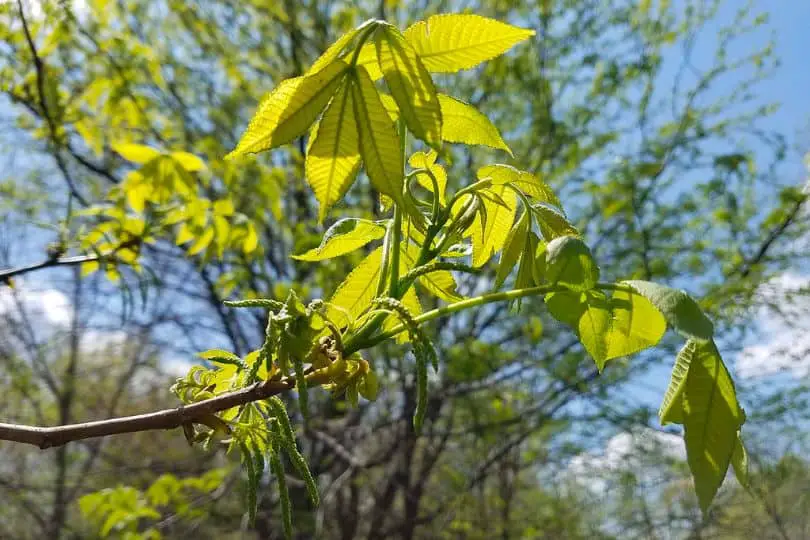
- Scientific Name: Carya cordiformis
- Common Name(s): Bitternut Hickory
- Mature Height: 50-70 feet (15-21 meters)
- Native Region: North America
- Flowers: No flowers
- Fruit: Bitternut hickory produces fruit with a bitter flavor that is unpalatable to most animals.
- Uses: Bitternut hickory wood is hard and durable, making it suitable for various purposes such as pulp and lumber for furniture, paneling, dowels, tool handles, ladders, charcoal, and fuelwood.
Bitternut hickory is a deciduous tree endemic to North America. It is most typically seen in Michigan’s southern Lower Peninsula. This tree is valued for its firm, sturdy wood, which makes it useful in a variety of uses.
Bitternut hickory can grow in both wetter lowland and dry upland locations in Michigan landscapes. It prefers moist, well-drained soil in bright sunlight. The tree’s general shape is circular, spherical, and upright. The bitternut hickory stands out in the winter with its bright yellow buds and slender, pale twigs with smooth ridges.
Bitternut hickory leaves are simple and finely serrated. They have an alternate growth pattern on the branches and have seven to eleven leaflets. This tree, however, does not have blooms. Instead, it produces fruit that most animals avoid due to its unpleasant flavor.
The bitternut hickory is valued for its wood in Michigan. It is used in the manufacture of furniture, paneling, dowels, tool handles, and ladders. In addition, the wood is used to make charcoal and fuelwood.
It is critical to offer well-drained soil and plenty of sunlight while caring for bitternut hickory trees in Michigan landscaping. Watering is required on a regular basis, especially during dry spells. Pruning is necessary to keep the ideal form and to eliminate any dead or unhealthy branches.
3. Pignut Hickory
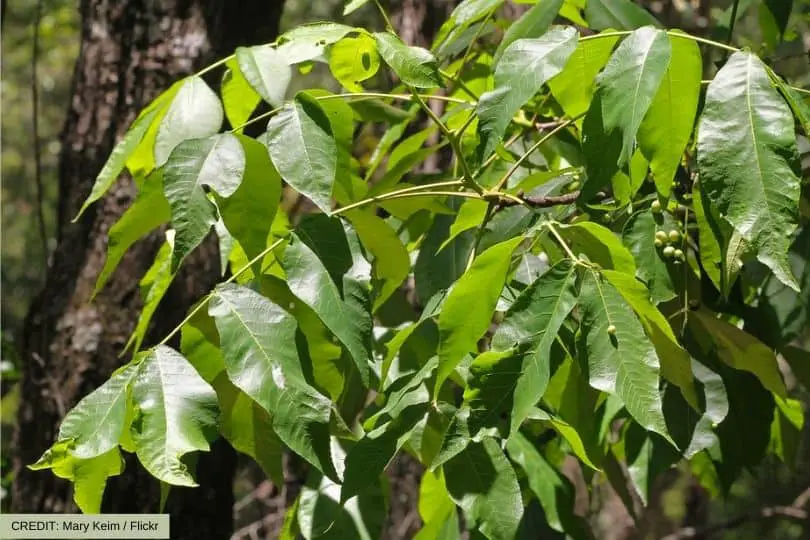
- Scientific Name: Carya glabra
- Common Name(s): Pignut Hickory
- Mature Height: 50-80 feet (15-24 meters)
- Native Region: Eastern and central North America
- Flowers: No flowers
- Fruit: Small, brown nuts with thick husks
- Uses: The wood of the Pignut Hickory is commonly used for furniture, tool handles, and flooring. The nuts are consumed by wildlife and can also be used for cooking and baking.
The Pignut Hickory (Carya glabra) is an eastern and central North American hardwood tree. It grows tall and straight, reaching mature heights of 50 to 80 feet (15 to 24 meters). Pignut Hickory has a dense and rounded canopy, as well as compound leaves with 5 to 7 leaflets.
When young, the bark of the Pignut Hickory is light gray and smooth, but it becomes rough and checkered with age. The tree produces little, inconspicuous blossoms that are unnoticed. The fruit of the Pignut Hickory, however, is the most notable. Small, brown nuts with thick husks are produced by the tree. These nuts provide a vital source of food for a variety of animal species, including squirrels and birds. In addition to their wildlife significance, the nuts are edible and are frequently used in cooking and baking.
Pignut Hickory is often found in highland woods in Michigan and grows best on well-drained soils. It is a slow-growing tree that thrives in full sun. The Pignut Hickory, like most hickory trees, is pest and disease-resistant, making it a low-maintenance option for homeowners. It should be noted, however, that the tree may drop nuts and leaves, necessitating regular cleaning.
Michigan residents value the Pignut Hickory for its hardwood, which is used to make furniture, tool handles, and flooring. Because of its strength and longevity, the wood is a popular choice for a variety of woodworking projects. Foragers also collect the nuts of the Pignut Hickory, which are used in baking or as a healthful snack.
4. Mockernut Hickory
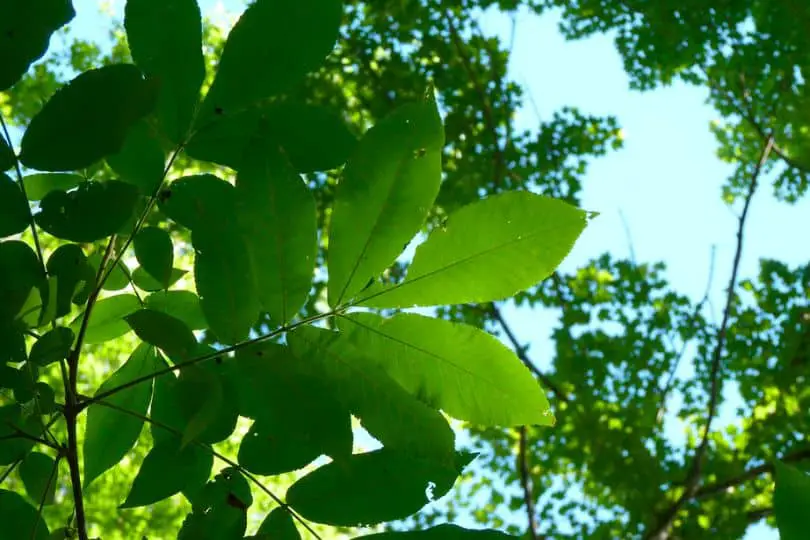
- Scientific Name: Carya tomentosa
- Common Name(s): Mockernut Hickory, White Hickory, Bullnut Hickory
- Mature Height: 60-80 feet (18-24 meters)
- Native Region: Eastern and central United States
- Flowers: No Flowers
- Fruit: Large, round, thick-shelled nuts
- Uses: Mockernut hickory wood is used for furniture, tool handles, and flooring. The nuts are edible and are used in baking and cooking.
Mockernut hickory (Carya tomentosa), also known as White Hickory or Bullnut Hickory, is a tall deciduous tree that can grow to be 60 to 80 feet (18 to 24 meters) tall when mature. It is indigenous to the eastern and central United States, including Michigan. The tree has a large crown and a strong trunk with grayish-brown bark that furrows deeply with age.
Mockernut hickory leaves are compound, alternating, and pinnately compound, with 7-9 leaflets. Each leaflet has a serrated edge and is lance-shaped. In the fall, the foliage becomes a vivid yellow, providing magnificent autumn colors to the environment.
The blossoms of the mockernut hickory are not particularly showy. It instead produces enormous, spherical, thick-shelled nuts in the fall. These nuts are wrapped in a husk that splits open to release the nut. The nuts have a deep, sweet flavor and are edible. They’re popular in baking and cookery.
Mockernut hickory grows well in a range of soil types in Michigan, including well-drained sandy and loamy soils. It prefers full sun but may tolerate moderate shade. The tree is well-suited to Michigan’s environment due to its resilience and drought tolerance.
Mockernut hickory wood is heavy, durable, and sturdy, making it perfect for a wide range of woodworking projects such as furniture, tool handles, and flooring. It is also utilized in the manufacturing of charcoal. Furthermore, the nuts can be harvested and consumed or used as wildlife food. The tree also supplies important habitat and food for a variety of wildlife species.
Regular watering is essential for mockernut hickory maintenance in Michigan settings, especially during dry years. Mulching around the base of the tree aids in moisture retention and weed control. Pruning may be required to keep the ideal shape and to eliminate any damaged or unhealthy branches. Regular pest and disease inspections are also advised to ensure the tree’s health and longevity.
5. Shellbark Hickory
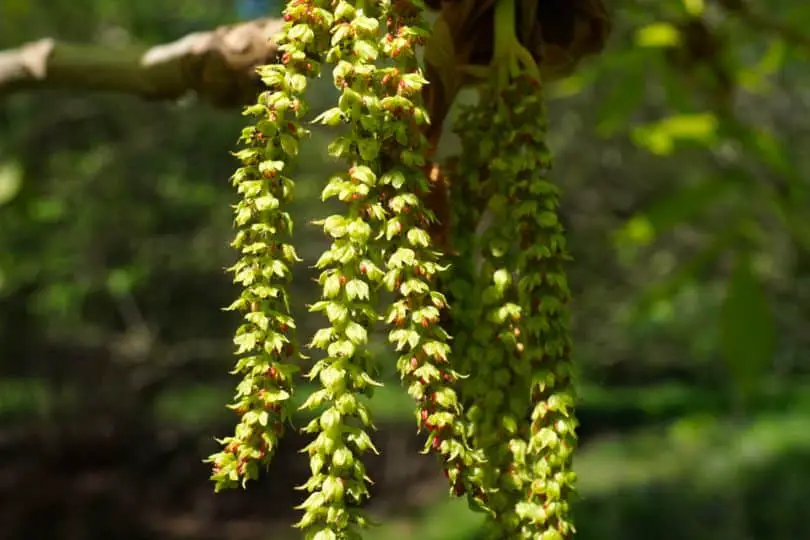
- Scientific Name: Carya laciniosa
- Common Name(s): Shellbark Hickory, Kingnut Hickory, Bigleaf Shagbark
- Mature Height: 60-80 feet (18-24 meters)
- Native Region: Eastern United States and Midwest
- Flowers: No flowers
- Fruit: Large, round or oblong nuts with thick shells and sweet kernels
- Uses: Timber for furniture and tool handles, nuts are edible and used in cooking, and the tree provides shade and wildlife habitat.
The Shellbark Hickory (Carya laciniosa) is a huge deciduous tree that can grow to heights of 60 to 80 feet (18 to 24 meters). It is most common in the eastern and midwestern United States, especially Michigan. The tree’s bark is shaggy and can peel off in large strips, giving it a distinct appearance.
Shellbark Hickory leaves are compound and can grow to be up to 20 inches long, with 7 to 9 leaflets. The leaflets are lance-shaped and dark green in hue, with serrated edges. They turn a gorgeous golden yellow in the fall, giving aesthetic value to the environment.
Shellbark Hickory enjoys rich, well-drained soils, making it well-suited to Michigan’s fertile landscapes. It is typically found in bottomland forests, river banks, and upland woods.
Shellbark Hickories don’t have showy flowers. They rely on wind pollination instead. This tree is known for its enormous, round or oblong nuts, which have thick shells and tasty kernels. These nuts are edible and are commonly used in cuisine, notably in the preparation of pies and other pastries.
Because of its strength and durability, the Shellbark Hickory is valued in Michigan for its lumber, which is often used for furniture, flooring, and tool handles. The nuts are also highly prized for their flavor and can be eaten raw or cooked into a variety of meals.
While caring for shellbark hickory trees in Michigan, you must supply it with well-drained soil and plenty of sunlight during the early stages. During dry conditions, regular irrigation is required, especially during the tree’s early years. Pruning may be necessary to keep the tree in shape and to remove dead or damaged limbs.
6. Red Hickory

- Scientific Name: Carya ovalis
- Common Name(s): Red Hickory
- Mature Height: 60-80 feet (18-24 meters)
- Native Region: Eastern and central North America
- Flowers: No Flowers
- Fruit: Small, round nuts enclosed in a thick husk
- Uses: Woodworking, furniture making, tool handles, and firewood.
Red Hickory, formally known as Carya ovalis, is a deciduous tree that can grow to be 60-80 feet (18-24 meters) tall when mature. This tree is native to North America’s eastern and central regions, including Michigan. Because of its strength and durability, Red Hickory is a popular choice for woodworking, furniture manufacturing, tool handles, and firewood.
Red Hickory leaves are complex, with 7-9 leaflets. They are tapering and elongated, with serrated edges. With shallow furrows and ridges, the bark is rough and grayish-brown. The leaves become a gorgeous yellow or orange hue in the fall, adding to the tree’s visual attractiveness in Michigan landscapes.
Red Hickory grows best in well-drained, wet soils and prefers full sun to light shade. It may grow in a variety of soil conditions, including sandy and clay soils. This tree is versatile and can tolerate occasional flooding, making it suited for places with high water levels on a regular basis.
While Red Hickory does not have spectacular blossoms, it does have little nuts encased in a thick shell. These nuts are edible and provide a vital source of food for wildlife such as squirrels, deer, and birds. Aside from its ecological importance, Red Hickory provides refuge and nesting opportunities for a variety of bird species.
It is advised that Red Hickory in Michigan landscapes be watered on a regular basis, especially during droughts. Mulching around the tree’s base can assist maintain soil moisture and inhibit weed growth. Pruning should be done late in the winter or early in the spring to remove any dead or damaged branches and promote healthy growth.
Red hickory is prized in Michigan not only for its wood, but also for its aesthetic appeal and ecological benefits. It is often utilized in woodworking applications such as furniture construction and tool handle fabrication. Furthermore, because of its great burning qualities and high heat output, Red Hickory is a popular choice for firewood.
Similar Articles
- Native Birch Trees In Michigan
- Native Elm Trees In Michigan
- Common Nut Trees In Michigan
- Common White Bark Trees In Michigan
- Common Ash Trees In Michigan
- Common Willow Trees In Michigan
- Common Spruce Trees In Michigan
- Red Flowering Trees In Michigan
- Common Maple Trees In Michigan
- Purple Trees In Michigan
- Common Yellow Trees In Michigan
- Common White Flowering Trees In Michigan
- Common Oak Trees In Michigan
Common Hickory Trees In Michigan – Sources
The Regional Gardening team makes sure that the information in our articles is accurate by only using sources that are known to be trustworthy. Some of these sources are peer-reviewed journals from government agencies, well-known universities, and scientific research organizations.
- Book – Michigan Trees A Guide to the Trees of the Great Lakes Region
- Book – Field Manual of Michigan Flora
- Book – Trees Of Michigan Field Guide
- Michigan’s Forests, Department of Natural Resources
- Michigan Botanical Society
- LSA Herbarium, University Of Michigan
- Department Of Forestry, Michigan State University
- Michigan Nature Association


